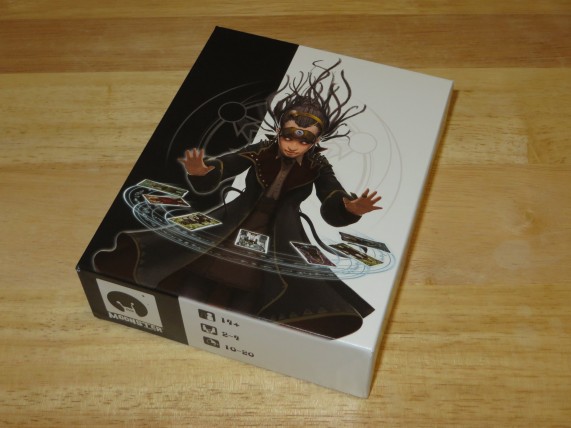Game Review: Koryo
Since yesterday was International Tabletop (Gaming) Day, it seemed only appropriate to add some more substance to my addiction in the form of a new game. When it comes to games, my brain tends to go for lots of systems, intricacies, and complexities. Sure, there are some exceptions, but for every Pente that I favor, I could list five Pathfinder Adventure Card Game’s or Firefly’s (yup, I like the boardgame – and the comic, because Firefly – too!)
Koryo, interestingly enough, has both simplicity and complexity.
![The Spy, Guardian, and Broadcaster cards with the initiative token [bottom] and victory tokens. - Koryo](http://blogadin.com/wp-content/uploads/2014/04/IMG_0163-e1397088263160-1024x578.jpg)
The Spy, Guardian, and Broadcaster cards with the initiative token [bottom] and victory tokens. – Koryo
Summary
As a card game loosely based in a steampunk version of 10th century Korea – known as Koryo at that time, which also included Manchuria – the object of Koryo is to have the most “influence” after eight rounds of play. To earn influence, you must end the game with more of one card type in play than any of your opponents; if two or more players are tied for the most in play, nobody earns any influence for them. Cards are numbered 1-9, and the amount of cards in the deck of any given type is equal to the number of the card itself, e.g. there are nine 9′s in the deck, eight 8′s, etc, and if you have the most 9′s in play at the end, you earn 9 influence.
Each turn, or “season”, starts with all players being dealt a certain amount of cards. Of those cards, each player will then choose one type of card to play, and can play as many of that type of card as they desire, with the remaining cards being returned to the deck. The players then take turns playing their cards to their field, and at the end of the turn, removing cards from their field that exceed the allowed number for the season. Cards dealt each season are inversely related to the cards you can keep. Season 1 starts with each player getting dealt ten cards and a field limit of three, whereas season 8 allows players to only receive three cards, but can have a total of ten in play.
The kicker in all this is that each card type has a special ability – some are passive, some are active – that can impact how many cards you receive, how many cards you can have in play, etc. There are also event cards that allow players to directly attack other players, albeit at a small cost to themselves, by destroying their cards or swapping them. Between the cards’ abilities, attacking possibilities, and cards in your opponents’ fields, Koryo reveals itself to be a fantastic game of situational tactics.
The Good
There’s really quite a bit to like about this game.
The art. I start here because it’s really the first thing you notice. The cover is an alternate image of The Omniscient (the only “1″ in the game) depicting him playing Koryo. As you browse through the cards, you notice that there’s not a single word printed on the cards – only art and numbers, with a symbol or two helping to remind players what the card’s special ability is. This was surely done to allow for cheaper printing and easier international distribution – the game is made by a Korean, published by the French, and distributed all over. This benefits the steampunk and anime lovers out there, though, as the artwork is excellent.
The gameplay. Each game is different based on card randomization and number of players, so there’s lots of variety and replayability. It’s also quite quick to play through, so it’s perfect for situations where time is at a premium. Also, the special abilities really help make the tactical nature of the game shine through – this aspect was very nicely done.
The Bad
The cards. In today’s gaming world, if you make cards other than standard size and your name isn’t Konami or Fantasy Flight, you’re wrong (and even if you’re one of those two companies, you’re still wrong, but you’re big enough to get away with it). This is especially applicable to games requiring heavy shuffling, which Koryo certainly does. The cards are more tarot-sized so they can’t fit in standard sleeves, and their length makes them easier to bend or crease while shuffling. To make matters worse, the cards are paper rather than plastic, and fairly thin stock at that. Even Cards Against Humanity has better card stock, and it’s nothing but black and white words! Poor, poor choices by the developer and publisher.
The rules. While I love the abilities of the various card types and the tactical choices they allow for, this also makes learning/teaching the game cumbersome, and all but requires the rulebook to be by your side when you first start playing. Not only that, but there’s a fairly high amount or rule verbiage for a small, single-deck card game. While I personally like the complexities, many perfer their games more simplified. The premise of the game is simple, but the execution is not.
The Wrap-up
Koryo is a solid game! The gameplay is cerebral and fun, but not so strategic that it makes you tired. Shuffling is a bit of a pain and the specific card rules can make the game a bit combersome to get into, but if you can get past the the initial learning curve, you’ve got something pretty good on your hands. I got into the game for $8, and it’s a value at that price. I’ve seen others have it listed for $20 or more, and that’s a bit much for only 60+ cards and a bit of cardboard.
The score: 7/10
Game: Koryo
Year: 2013
Designer: Gary Kim
Publisher: Moonster Games
Players: 2-4
Game length: 15-30 minutes
← Absence makes the heart grow fonder, right?



